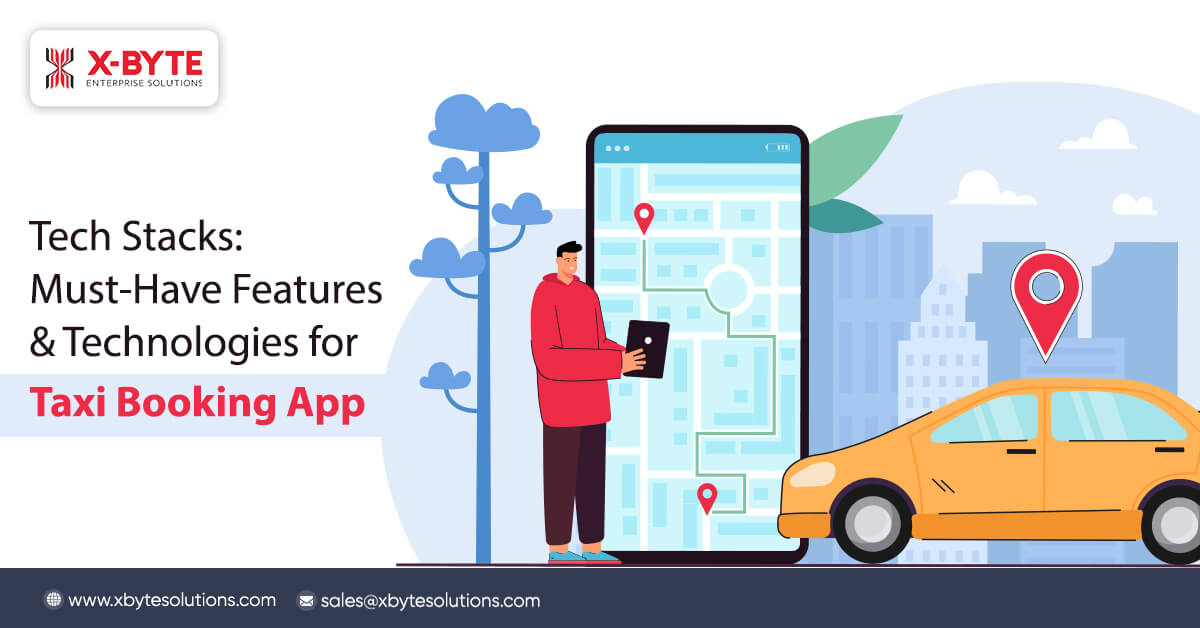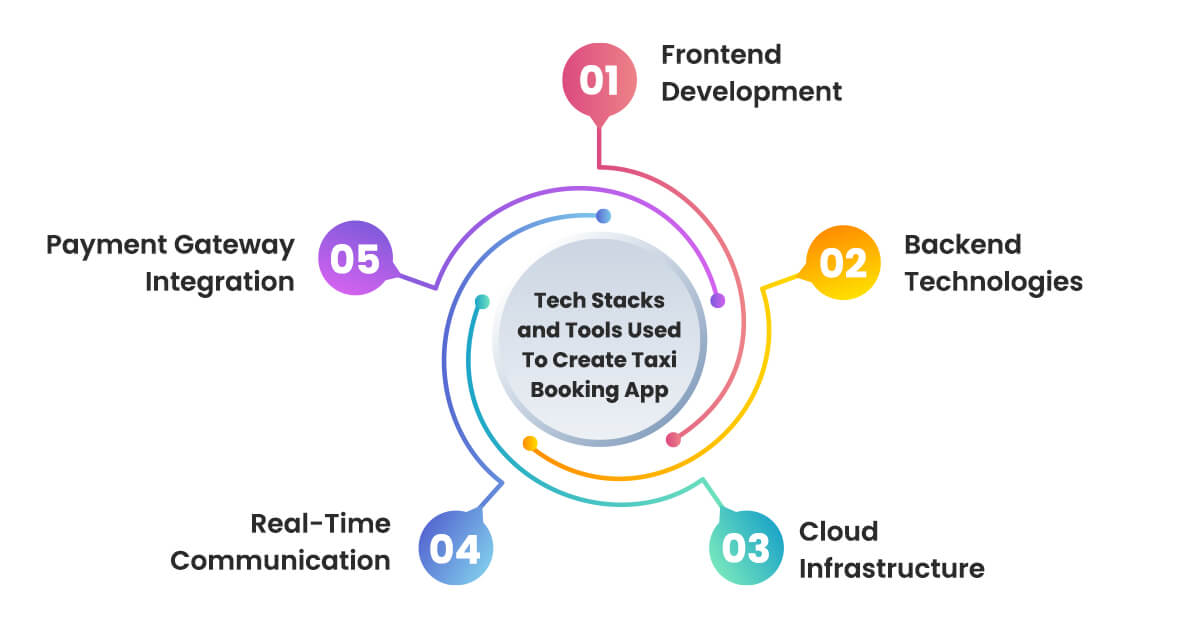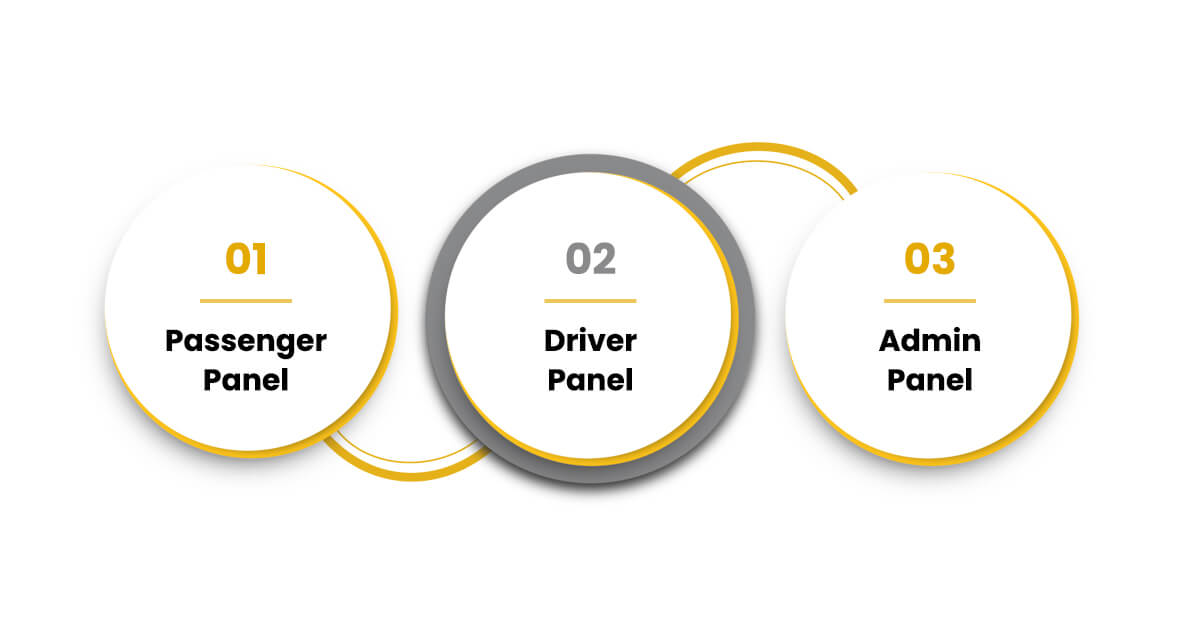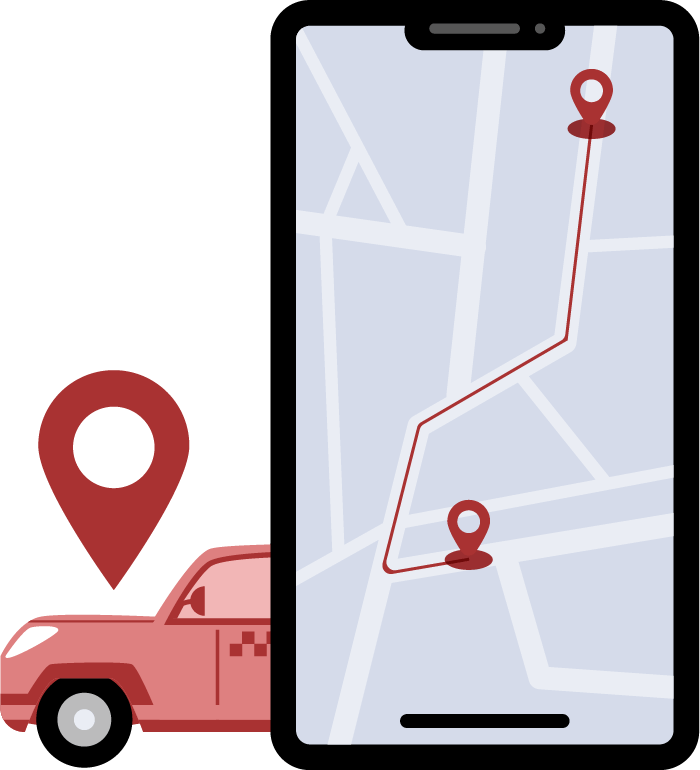
Quick Summary :The modern scenario has transformed the travel industry. Understanding the most required features, the best technology stack for taxi apps to use, and third-party integration tools to use helps in feature-rich taxi booking app development. Establish a clear ride-hailing app development process for a budget-friendly taxi app development stack at ease.
The need for on-demand taxi services has grown and gained popularity in recent years. More companies are looking forward to experiencing growth and opportunity in this industry. They seek the best mobile app development companies to provide high-tech, innovative solutions to boost revenue. It is important to use various tools and technologies to provide feature-rich apps. Many major and small companies are currently vying with one another to dominate the taxi booking industry.
Let us now examine the taxi booking app’s worldwide market perspective.
- Globally, the market for taxi reservations is growing at a rapid pace. It was expected to be worth around $23.62 billion in 2020 and $28.55 billion in 2021 at a compound annual growth rate of 22.3%.
- At a CAGR of 9.5%, the market is expected to reach 41.22 billion dollars by the end of 2025.
- The global market for online taxi services grew at a Compound Annual Growth Rate (CAGR) of 12.2% from $31.03 billion in 2021 to $34.82 billion in 2022, according to research by The Business Research Company.
- The market for online taxi services is projected to reach $53.48 billion in 2026 at a compound annual growth rate (CAGR) of 11.3%.
In basic terms, there is a lot of competition in the taxi industry. One crucial consideration is that your app needs to be able to differentiate itself from the competitors. On the other hand, the on-demand delivery app technology stack creates a unique solution that needs to be highly productive both at the front and back ends. It can done by ensuring massive performance optimization and flawless connection required.
Tech Stacks and Tools Used To Create Taxi Booking App

It is essential to adopt a diversified taxi app development technology stack for unique solutions. A suitable technology stack for ride-hailing apps ensures global taxi booking trends for a successful on-demand taxi service.
1. Frontend Development:
The frontend technologies for taxi apps provide a portal for users to access and engage with the system. The user experience is greatly influenced by it, from easy ride-booking to simple navigation and payment processing. Below is a more thorough explanation of frontend technologies for taxi apps used in frontend development:
Mobile platforms
On-demand taxi apps are available for mobile platforms for taxi apps, including iOS and Android users, covering a broad spectrum of people. It is important to choose an advanced mobile app development stack for taxi booking. In this modern scenario, cross-platform app development for taxi apps has taken a boost.
Developers use specific programming languages and tools for iOS app development and Android mobile application development to ensure high performance and compatibility for mobile app development for taxi booking:
-
- iOS Development
Developers use languages like Swift or Objective-C to make apps for iPhones and iPads. Swift is famous for its modern style and improved performance, making it a favorite for building iOS apps.
-
- Android Development
For apps on Android phones and tablets, developers use Kotlin or Java. Google has recognized Kotlin as an Android first-class language that streamlines the development process with its null safety, simple syntax, and easy integration with existing Java codebases.
Design of User Interfaces (UI)
To create aesthetically pleasing and intuitive user interfaces that captivate and please consumers, adopting UI/UX design modern practices for taxi apps is essential. Adopting a budget-friendly taxi app development stack to design the app layout transforms the user experience with responsive design for taxi apps.
Designers use different tools and techniques to make this happen:
-
- Visual Design Tools
Designers use special tools like Sketch, Adobe XD, and Figma to create designs that look real. They can make digital mockups and wireframes. These tools also let designers try different ideas quickly, which helps them make the best design possible.
-
- Responsive Design
Designers must ensure that their designs function well across various devices, including phones and tablets with varying screen sizes. Regardless of the device type, responsive design ensures that the application is visually appealing and user-friendly.
-
- Platform Guidelines
Google and Apple, which make the software that runs on most phones, have their own rules for how apps should look and work. Google’s Material Design is for apps on Android phones, and Apple’s Human Interface Guidelines are for iPhone apps. By following these rules, designers can make apps that look and feel familiar to people, which makes them easier to use.
Libraries and Frameworks
Frameworks and libraries for frontend development give programmers the building blocks and instruments they need to expedite work, improve efficiency, and preserve code quality:
-
- Cross-Platform Development
Imagine creating an app that functions on Android and iPhone smartphones without starting from scratch every time. This is made feasible by frameworks like Flutter and React Native. They allow programmers to build code that is compatible with both kinds of phones only once. Cross-platform app development for taxi app helps to employ unique techniques to ensure the app functions quickly and looks excellent on all phone types.
-
- State Administration
Have you ever used an app where the content seemed to be updated constantly? The reason for this is that applications must monitor activities and ensure that everything remains organized. This is made easier by frameworks like Redux and MobX. These help developers simplify data flow between components and maintain a consistent application state.
2. Backend Technologies
The backend of a taxi booking app is like the control center that connects different parts of the app. It’s where the server, middleware (which helps different parts of the app talk to each other), and database meet and work together. It is important to choose the multi platform compatible programming languages for taxi apps.For example, the backend makes it happen when you book a ride or track a driver’s location.
Developers may create robust and dependable systems that enable the cab app to function flawlessly on both iOS and Android smartphones by utilizing these technologies and frameworks. It’s building a sturdy foundation for a house – it ensures the app is solid and can handle scalability and performance optimization for taxi apps.
- Developers can employ diverse tools and backend frameworks for taxi apps like Java, Python, Go, and Swift to make all of this work. With the use of these technologies, a robust and dependable backend system that can manage large amounts of data and maintain operations may be built.
- Developers use frameworks like RIBs (which stands for Routers, Interactors, and Builders). These frameworks make it easier to put in place the rules and logic that run the taxi app.
- One layer deals with what users see and do.
- Another handles the behind-the-scenes activities like processing requests and other talks to the database where all the information is stored.
In simple terms, the backend of a taxi booking app is like the engine that powers everything and makes sure it all works together smoothly.
3. Cloud Infrastructure
Cloud infrastructure is like the strong foundation of a building—it provides the necessary support and resources for an on-demand taxi app technology to run smoothly and securely. Let’s take a closer look at the main parts of cloud infrastructure for taxi apps and how they help the app work well:
Computer Services
Computer services are like powerful engines that run the behind-the-scenes operations of the app. They handle tasks like processing user requests and running the app’s code. Here are some examples:
-
- Amazon EC2
Consider Amazon EC2 having a bunch of virtual servers that can grow or shrink based on how many people use the app. It ensures the app can handle a lot of users without slowing down.
-
- Google Compute Engine
Google’s Compute Engine is similar, offering virtual machines that can be customized to fit the app’s needs. It’s like having a flexible set of tools to make sure everything runs smoothly.
-
- Azure Virtual Machines
Microsoft’s Azure Virtual Machines are like on-demand computers that can be quickly set up and used to run the app’s code. They support different operating systems, giving developers options for building their apps.
These computing services make sure the app can handle lots of users and work efficiently, even when there’s a lot going on.
Storage Services
Storage services are like big, secure rooms where the app keeps all its essential information. They provide safe and scalable storage solutions for things like user data, pictures, and backups. Here’s how they help:
-
- Amazon S3
Amazon S3 is like a huge storage warehouse where the app can store and retrieve data. It’s great for keeping big files like pictures and videos safe and accessible.
-
- Google Cloud Storage
Google Cloud Storage is similar, offering a reliable place to store static content like images and documents. It’s like having a safe deposit box for essential files.
-
- Azure Blob Storage
Azure Blob Storage is like a giant digital closet where the app can organize all kinds of data. It’s good for storing things like text or binary data in a way that’s easy to manage and access.
These storage services ensure the app’s data is kept safe and can be easily accessed whenever needed.
Networking Services:
Networking services are like the roads and highways connecting different parts of the app. They make sure all the pieces can communicate with each other securely. Here’s how they work:
-
- Amazon VPC
Amazon Virtual Private Cloud is like a private network within the cloud where the app’s different parts can talk without anyone else listening in. It’s like having a private phone line for meaningful conversations.
-
- Google VPC
Google Virtual Private Cloud is similar, providing a secure way for the app’s components to communicate within the Google Cloud Platform. It’s like having a unique network just for the app.
-
- Azure Virtual Network
Azure Virtual Network is like a secure tunnel connecting the app’s different parts, ensuring they can communicate safely and efficiently. It’s like having a direct line between essential places.
Ever wondered about creating a feature-rich taxi booking app?
4. Real-Time Communication
Real-time communication is the basis of on-demand taxi apps. It keeps users connected and informed about their rides as they happen. Let’s take a closer look at the tools that make this happen:
Websockets:
Websockets are like open channels of communication between the app and its servers to ensure real-time communication in taxi apps. They allow information to flow back and forth instantly by making sure of a direct line of communication.
- Unlike traditional methods where information flows in one direction, web sockets allow both the app and the server to send messages to each other whenever needed, without waiting for a response.
- This real-time communication is essential for features like live ride tracking, where users can see where their driver is on a map as they drive toward them.
- Because of its lightweight and efficient nature, websockets don’t require a lot of resources. This ensures that there are no lags and that the program functions swiftly and seamlessly.
Push Notifications:
Push notifications are like little messages that pop up on a user’s device to keep them updated about important things related to their rides.
- Services like Firebase Cloud Messaging (FCM) and Apple Push Notification Service (APNs) allow the app to send these notifications to users’ devices in real time.
- These notifications can be personalized based on things like the user’s preferences and behavior. For example, users might be notified when their driver is nearby or a special offer is available.
- Push notifications motivate consumers to act by informing them, such as confirming a ride or redeeming a voucher. This drives users to interact with the app and return.
5. Payment Gateway Integration:
Payment gateway integration, like the cashier at the checkout, enables consumers to pay for their trips quickly and securely within the on-demand taxi app. Let’s look at the technology and platforms to ensure secure payment gateway integration for taxi apps that enhance accessibility.
Stripe
Stripe is similar to an all-in-one payment solution for on-demand taxi applications since it provides features and capabilities that simplify payment processing. Here’s why Stripe is a popular choice:
- Stripe offers easy-to-use APIs and detailed documentation, making it simple for developers to add payment capabilities to their projects. This streamlines the development process and shortens time-to-market.
- Stripe accepts various payment methods and currencies, making it ideal for worldwide app deployments.
- Stripe allows customers to pay with credit/debit cards, digital wallets, or in-app wallets.
- Stripe prioritizes security, including strong encryption and fraud protection techniques, to secure user data and transactions. This builds confidence in users and guarantees that their payment information is safe and secure.
PayPal
PayPal is a trustworthy partner for online payments. It is a well-known and commonly utilized payment gateway that customers feel at ease with. Here’s why PayPal is such a popular option for on-demand taxi apps:
-
- Secure Transactions
PayPal provides secure payment processing and powerful fraud detection tools to ensure that transactions are safe and secure. This gives users peace of mind, knowing their financial information is secure.
-
- Convenience
PayPal allows customers to make payments without entering their credit or debit card information every time. Users may complete their orders with a few easy clicks.
-
- Buyer Protection
PayPal offers steps to protect consumers from unlawful transactions and fraudulent activities. This builds user trust and confidence, enabling them to make payments through PayPal.
There are many other payment gateways that can be integrated in the taxi booking apps. For example:
- Braintree
- RazorPay
- GooglePay
- Paytm
- PayU
- Instamojo
- CCAvenue
- Bill Desk
- JusPay
- Airpay
- Cashfree Payments
- Zaakpay
How Do Taxi Apps Like Uber Work?

Choosing the right tech stack for a taxi app helps to create an optimized solution. A typical taxi app comprises three interconnected parts: a driver app, a passenger app, and an admin panel for company administration functions. The following are the procedures to take while hiring a cab.
Passenger Panel
- Enable location services on your smartphone.
- First Sign-up / Social Login
- Create and maintain the profile.
- On-demand taxi booking components
- View the anticipated waiting time for the taxi to arrive.
- Real-time taxi tracking.
- Acceptable billing and payment alternatives
- Push notifications and SMS alerts
- View taxi and fare options.
- Schedule reservations
- Automatically generated fare
- Payment with in-app wallet.
- View the taxi booking history.
Driver Panel
- Update the status for customers.
- Accept or deny consumer booking requests.
- Push notifications
- In-app chat and call with passengers.
- Live map navigation
- View the ratings and reviews.
- Automated fare estimates
- Check the trip routes.
- Accept offline and internet payments.
Admin Panel
- View/Manage Panel Users
- Manage taxi availability and scheduling.
- View travel routes
- Manage pricing and rate cards.
- Manage offers and discounts.
- Tracking taxis
- View and manage feedback and evaluations of drivers.
- Generate daily reports for transactions and revenues.
- Manage geolocation borders.

Our expertise assists in integrating third-party applications into your taxi mobile application seamlessly.
Conclusion
It is essential to choose a specified tech stack to ensure the smooth flow of the application. Comparing technology stacks for taxi apps helps ensure real-time location tracking technology for taxi apps. To make sure your online taxi booking service is successful when you launch it, you need to focus on two things: marketing and understanding user needs. If you’ve researched and know what problems your customers have, you’ll be in an excellent position to start your service. In order to ensure the success of an app, it is crucial to conduct thorough research and preparation before launch. X-Byte Solutions has expertise in creating tailored taxi booking app development solutions.
Frequently Asked Questions
How do you develop an app for food delivery?
There are predetermined steps required to follow to develop an optimized and feature-rich solution
- Choose the Business Model
- Choose a Software Development Partner
- Discovery Phase
- Selecting Main Features
- Tech Stack
- Development
- Testing and Maintenance
What is the price of developing an app similar to Uber Eats?
What Is The Best Technology Stack To Select For Delivery Applications?
There are a few guidelines you should adhere to while choosing the ideal tech stack for delivery apps.
- App Specifications
- Objectives for Mobile Apps
- Skill Sets for Organization
- Parent Business: Technology
- Several Platforms Operational Security Guidelines
- Harmony With Technology
